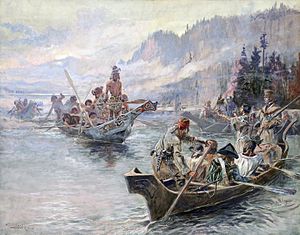Corps of Discovery
| Corps of Discovery | |
|---|---|

The Corps of Discovery meet Chinooks on the Lower Columbia, October 1805. (Charles Marion Russel, c.1905.)
|
|
| Active | 1803–1806 |
| Country | United States |
| Branch | Army |
| Role | Exploration |
| Size | 2 Officers 5 NCOs 30 Enlisted Civilians 3 Permanent 12 Temporary |
| Disbanded | September 1806 |
| Commanders | |
| Captain | Meriwether Lewis |
| Second Lieutenant | William Clark |
The Corps of Discovery was a specially-established unit of the United States Army which formed the nucleus of the Lewis and Clark Expedition that took place between May 1804 and September 1806. The Corps, which was a select group of volunteers, were led jointly by Captain Meriwether Lewis and Second Lieutenant William Clark. Commissioned by President Thomas Jefferson, the Corps' objectives were both scientific and commercial – to study the area's plants, animal life, and geography, and to learn how the Louisiana Purchase could be exploited economically.
The foundations for the Corps of Discovery were laid when Thomas Jefferson met John Ledyard to discuss a proposed expedition to the Pacific Northwest in the 1780s. In 1802, Jefferson read Alexander Mackenzie's 1801 book about his 1792–1793 overland expedition across Canada to the Pacific Ocean; these exploratory journals influenced his decision to create an American body capable of reaching the Pacific as well. Two years after taking the presidency, Jefferson asked Congress to fund an expedition through the Louisiana Purchase.
In 1803, President Thomas Jefferson commissioned the Corps of Discovery, and named as its leader his personal secretary and U.S. Army Captain, Meriwether Lewis, who selected William Clark as his partner. The goals of the Corps of Discovery, whose cadre would be raised primarily from the U.S. military, was to explore the Louisiana Purchase, and establish trade and U.S. sovereignty over the native peoples along the Missouri River. Jefferson also wanted to establish a U.S. claim to the Pacific Northwest and Oregon territory by documenting an American presence there before other Europeans, such as the British, could lay title to the land.
...
Wikipedia
